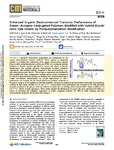Mostrar o rexistro simple do ítem
Enhanced Organic Electrochemical Transistor Performance of Donor–Acceptor Conjugated Polymers Modified with Hybrid Glycol/Ionic Side Chains by Postpolymerization Modification
| dc.contributor.author | Ding, Bowen | |
| dc.contributor.author | Jo, Il-Young | |
| dc.contributor.author | Yu, Hang | |
| dc.contributor.author | Kim, Ji Hwan | |
| dc.contributor.author | Marsh, Adam V. | |
| dc.contributor.author | Gutiérrez-Fernández, Edgar | |
| dc.contributor.author | Ramos, Nicolás | |
| dc.contributor.author | Rapley, Charlotte L. | |
| dc.contributor.author | Rimmele, Martina | |
| dc.contributor.author | He, Qiao | |
| dc.contributor.author | Martín, Jaime | |
| dc.contributor.author | Gasparini, Nicola | |
| dc.contributor.author | Nelson, Jenny | |
| dc.contributor.author | Yoon, Myung-Han | |
| dc.contributor.author | Heeney, Martin | |
| dc.date.accessioned | 2023-05-10T12:05:33Z | |
| dc.date.available | 2023-05-10T12:05:33Z | |
| dc.date.issued | 2023-04-11 | |
| dc.identifier.citation | Ding, B.; Jo, I.-Y.; Yu, H.; Kim, J. H.; Marsh, A. V.; Gutiérrez-Fernández, E.; Ramos, N.; Rapley, C. L.; Rimmele, M.; He, Q.; Martín, J.; Gasparini, N.; Nelson, J.; Yoon, M.-H.; Heeney, M. Enhanced Organic Electrochemical Transistor Performance of Donor–Acceptor Conjugated Polymers Modified with Hybrid Glycol/Ionic Side Chains by Postpolymerization Modification. Chem. Mater. 2023, 35 (8), 3290–3299. https://doi.org/10.1021/acs.chemmater.3c00327. | es_ES |
| dc.identifier.issn | 1520-5002 | |
| dc.identifier.uri | http://hdl.handle.net/2183/33049 | |
| dc.description.abstract | [Abstract] Emergent bioelectronic technologies are underpinned by the organic electrochemical transistor (OECT), which employs an electrolyte medium to modulate the conductivity of its organic semiconductor channel. Here we utilize postpolymerization modification (PPM) on a conjugated polymer backbone to directly introduce glycolated or anionic side chains via fluoride displacement. The resulting polymers demonstrated increased volumetric capacitances, with subdued swelling, compared to their parent polymer in p-type enhancement mode OECTs. This increase in capacitance was attributed to their modified side chain configurations enabling cationic charge compensation for thin film electrochemical oxidation, as deduced from electrochemical quartz crystal microbalance measurements. An overall improvement in OECT performance was recorded for the hybrid glycol/ionic polymer compared to the parent, owing to its low swelling and bimodal crystalline orientation as imaged by grazing-incidence wide-angle X-ray scattering, enabling its high charge mobility at 1.02 cm2·V–1·s–1. Compromised device performance was recorded for the fully glycolated derivative compared to the parent, which was linked to its limited face-on stacking, which hindered OECT charge mobility at 0.26 cm2·V–1·s–1, despite its high capacitance. These results highlight the effectiveness of anionic side chain attachment by PPM as a means of increasing the volumetric capacitance of p-type conjugated polymers for OECTs, while retaining solid-state macromolecular properties that facilitate hole transport. | es_ES |
| dc.description.sponsorship | Reino Unido. Engineering and Physical Sciences Research Council; EP/T028513/1 | es_ES |
| dc.description.sponsorship | República de Corea. Global Research Laboratory program; NRF-2017K1A1A2013153 | es_ES |
| dc.description.sponsorship | República de Corea. National Research Foundation of Korea; RF-2021R1A2C101301511 569 | es_ES |
| dc.description.sponsorship | República de Corea. National Research Foundation of Korea; 2021R1A2C1013015 | es_ES |
| dc.description.sponsorship | República de Corea. National Research Foundation of Korea; 2018M3A7B4070988 | es_ES |
| dc.description.sponsorship | República de Corea. National Research Foundation of Korea; 2021R1A4A1022920 | es_ES |
| dc.language.iso | eng | es_ES |
| dc.publisher | American Chemical Society | es_ES |
| dc.relation | info:eu-repo/grantAgreement/EC/H2020/742708 | es_ES |
| dc.relation.uri | https://doi.org/10.1021/acs.chemmater.3c00327 | es_ES |
| dc.rights | Attribution 4.0 International (CC BY 4.0) https://creativecommons.org/licenses/by/4.0/ | es_ES |
| dc.rights.uri | https://creativecommons.org/licenses/by/4.0/deed.es | * |
| dc.subject | Absorption | es_ES |
| dc.subject | Electrical properties | es_ES |
| dc.subject | Electrodes | es_ES |
| dc.subject | Polymers | es_ES |
| dc.subject | Thin films | es_ES |
| dc.title | Enhanced Organic Electrochemical Transistor Performance of Donor–Acceptor Conjugated Polymers Modified with Hybrid Glycol/Ionic Side Chains by Postpolymerization Modification | es_ES |
| dc.type | info:eu-repo/semantics/article | es_ES |
| dc.rights.access | info:eu-repo/semantics/openAccess | es_ES |
| UDC.journalTitle | Chemistry of Materials | es_ES |
| UDC.volume | 35 | es_ES |
| UDC.issue | 8 | es_ES |
| UDC.startPage | 3290 | es_ES |
| UDC.endPage | 3299 | es_ES |
| dc.identifier.doi | https://doi.org/10.1021/acs.chemmater.3c00327 |
Ficheiros no ítem
Este ítem aparece na(s) seguinte(s) colección(s)
-
GI-Polímeros - Artigos [29]
-
OpenAIRE [340]






